Future Colorado River Basin Drought and Surplus
Abstract
:1. Introduction
2. Materials and Methods
2.1. Data
2.1.1. Historical Streamflow
2.1.2. Future Projections of Streamflow
2.2. Drought and Surplus Definitions
2.3. Testing of Differences
3. Results
3.1. Station Specific Results for the Basin
3.1.1. Drought (Surplus) Duration
3.1.2. Drought (Surplus) Magnitude
3.1.3. Changes in Water Year Mean Flow
3.2. Further Analysis for Lees Ferry
4. Discussion
5. Conclusions
Author Contributions
Funding
Institutional Review Board Statement
Informed Consent Statement
Data Availability Statement
Acknowledgments
Conflicts of Interest
References
- Western Resources Advocates. Protecting the Colorado River Through Smarter Water Management Throughout the West. 2022. Available online: https://westernresourceadvocates.org/colorado-river-basin/ (accessed on 1 June 2022).
- Bureau of Reclamation. Interior Department Announces Actions to Protect Colorado River System, Sets 2023 Operating Conditions for Lake Powell and Lake Mead. Available online: https://www.usbr.gov/newsroom/news-release/4294 (accessed on 1 June 2022).
- Christensen, N.S.; Wood, A.W.; Voisin, N.; Lettenmaier, D.P.; Palmer, R.N. The Effects of Climate Change on the Hydrology and Water Resources of the Colorado River Basin. Clim. Chang. 2004, 62, 337–363. [Google Scholar] [CrossRef]
- Rajagopalan, B.; Nowak, K.; Prairie, J.; Hoerling, M.; Harding, B.; Barsugli, J.; Udall, B. Water Supply Risk on the Colorado River: Can Management Mitigate? Water Resour. Res. 2009, 45. [Google Scholar] [CrossRef]
- Miller, W.P.; Piechota, T.C. Trends in Western U.S. Snowpack and Related Upper Colorado River Basin Streamflow. J. Am. Water Resour. Assoc. 2011, 47, 1197–1210. [Google Scholar] [CrossRef]
- Miller, W.P.; Butler, R.A.; Piechota, T.C.; Prairie, J.; Grantz, K.; DeRosa, G.M. Water Management Decisions using Multiple Hydrologic Models within the San Juan River Basin Under Changing Climate Conditions. J. Water Resour. Plan. Manag. 2012, 138, 412–420. [Google Scholar] [CrossRef]
- Dettinger, M.; Udall, B.; Georgakakos, A. Western Water and Climate Change. Ecol. Appl. 2015, 25, 2069–2093. [Google Scholar] [CrossRef] [PubMed] [Green Version]
- McCabe, G.J.; Wolock, D.M.; Pederson, G.T.; Woodhouse, C.A.; McAfee, S. Evidence that recent warming is reducing upper Colorado River flows. Earth Interact. 2017, 21, 1–14. [Google Scholar] [CrossRef] [Green Version]
- Hoerling, M.; Barsugli, J.; Livneh, B.; Eischeid, J.; Quan, X.; Badger, A. Causes For the Century-Long Decline in Colorado River Flow. J. Clim. 2019, 32, 8181–8203. [Google Scholar]
- Udall, B.; Overpeck, J. The Twenty-First Century Colorado River Hot Drought and Implications for the Future. Water Resour. Res. 2017, 53, 2404–2418. [Google Scholar] [CrossRef] [Green Version]
- Woodhouse, C.A.; Smith, R.M.; McAfee, S.A.; Pederson, G.T.; McCabe, G.J.; Miller, W.P.; Csank, A. Upper Colorado River Basin 20th Century Droughts Under 21st Century Warming: Plausible Scenarios for the Future. Clim. Serv. 2021, 21, 100206. [Google Scholar] [CrossRef]
- Bureau of Reclamation. West-Wide Climate and Hydrology Assessment, Technical Memorandum No. ENV-2021-011. March 2021. Available online: https://www.usbr.gov/climate/secure/docs/2021secure/westwidesecurereport.pdf (accessed on 1 June 2022).
- Wallis, J.R.; Lettenmaier, D.P.; Wood, E.F. A Daily Hydroclimatological Data Set for the Continental United States. Water Resour. Res. 1991, 27, 1657–1663. [Google Scholar] [CrossRef]
- Tootle, G.A.; Piechota, T.C.; Singh, A.K. Coupled Interdecadal and Interannual Oceanic/Atmospheric Variability and United States Streamflow. Water Resour. Res. 2005, 41, W12408. [Google Scholar]
- Bureau of Reclamation. Downscaled CMIP3 and CMIP5 Hydrology Projections—Release of Hydrology Projections. 2014. Available online: https://gdo-dcp.ucllnl.org/downscaled_cmip_projections/techmemo/BCSD5HydrologyMemo.pdf (accessed on 1 January 2022).
- Maurer, E.P.; Wood, A.W.; Adam, J.C.; Lettenmaier, D.P. A Long-Term Hydrologically Based Dataset of Land Surface Fluxes and States for the Conterminous United States. J. Clim. 2002, 15, 3237–3251. [Google Scholar] [CrossRef]
- Riahi, K.; Rao, S.; Krey, V.; Cho, C.; Chirkov, V.; Fischer, G.; Rafaj, P. RCP 8.5—A Scenario of Comparatively High Greenhouse Gas Emissions. Clim. Chang. 2011, 109, 33–57. [Google Scholar]
- U.S. Global Change Research Program (USGCRP). Impacts, Risks, and Adaptation in the United States: Fourth National Climate Assessment, Volume II; U.S. Global Change Research Program: Washington, DC, USA, 2018. [Google Scholar]
- Pierce, D.; Kalansky, J.; Cayan, D. Climate, Drought, and Sea Level Rise Scenarios for California’s Fourth Climate Change Assessment; Scripps Institution of Oceanography: La Jolla, CA, USA, 2018; pp. 52–56. Available online: https://www.energy.ca.gov/sites/default/files/2019-11/Projections_CCCA4-CEC-2018-006_ADA.pdf (accessed on 1 January 2022).
- Lynam, L.; Piechota, T. California Drought Outlooks Based on Climate Change Models’ Effects on Water Availability. Water 2021, 13, 3211. [Google Scholar] [CrossRef]
- Ayers, J.; Ficklin, D.L.; Stewart, I.T.; Strunka, M. Comparison of CMIP3 and CMIP5 Projected Hydrologic Conditions over the Upper Colorado River Basin. Int. J. Climatol. 2016, 36, 3807–3818. [Google Scholar] [CrossRef]
- Lukas, J.; Barsugli, J.; Doesken, N.; Rangwala, I.; Wolter, K. Climate Change in Colorado: A Synthesis to Support Water Resources Management and Adaptation; University of Colorado; Colorado Water Conservation Board; Western Water Assessment, 2014; 114p., Available online: https://wwa.colorado.edu/climate/co2014report/Climate_Change_CO_Report_2014_FINAL.pdf (accessed on 1 June 2022).
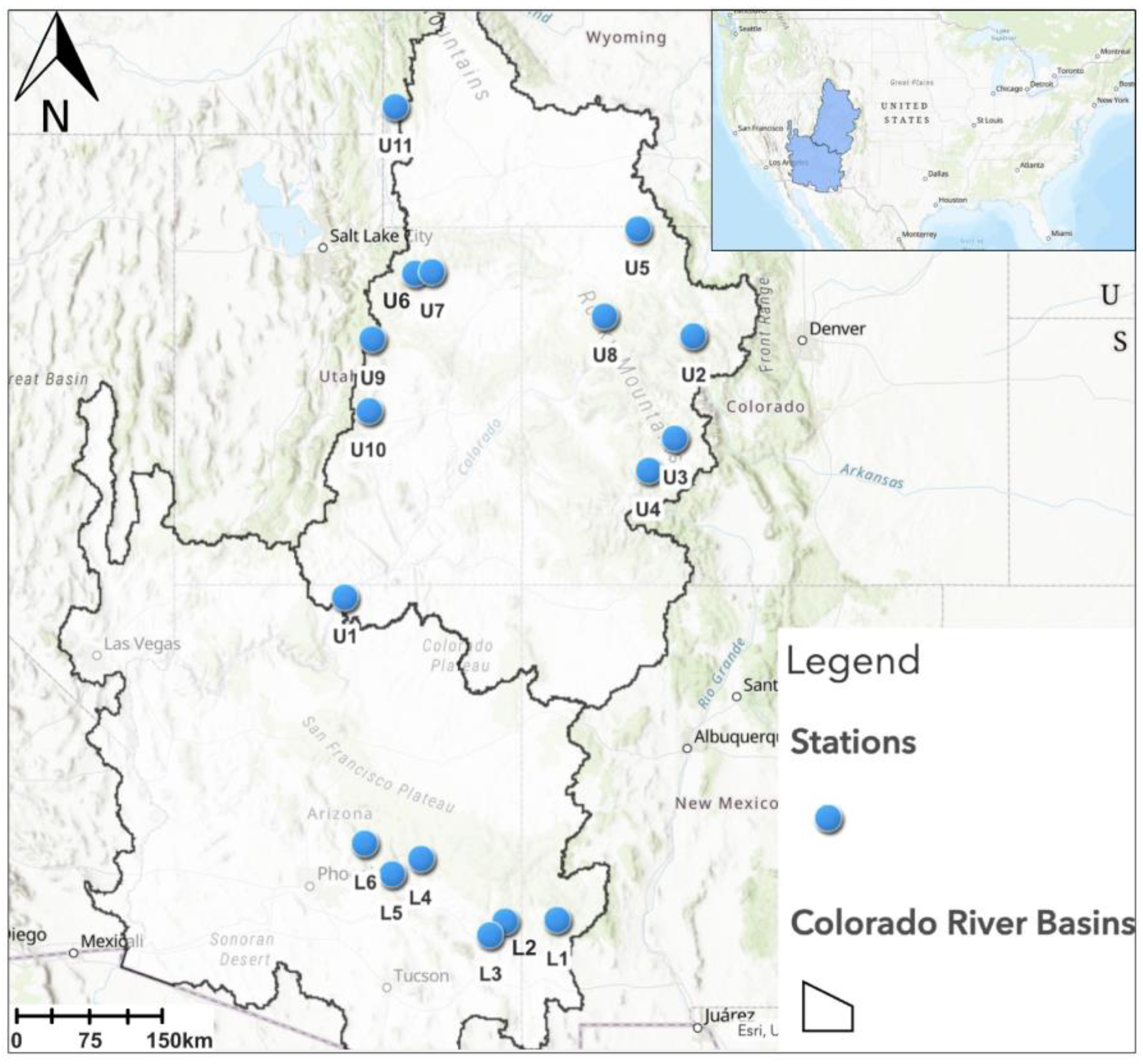
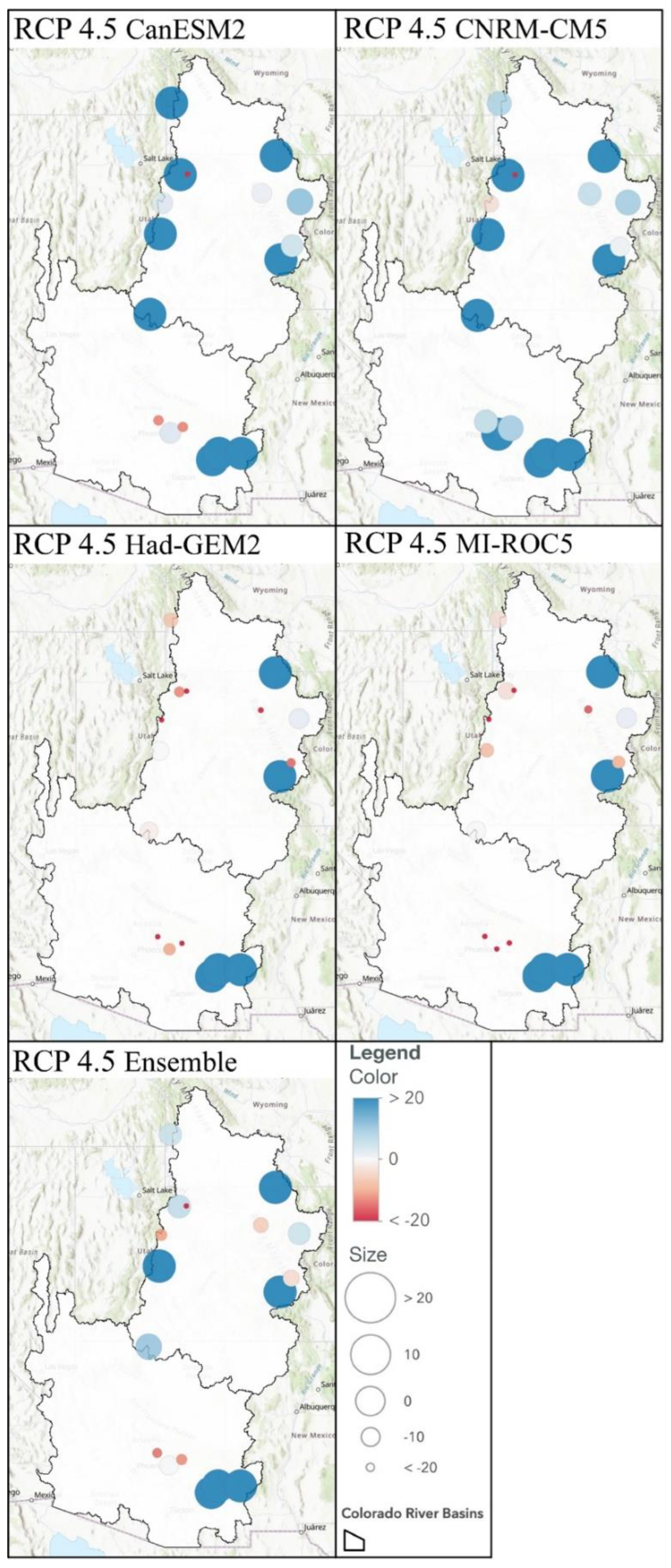
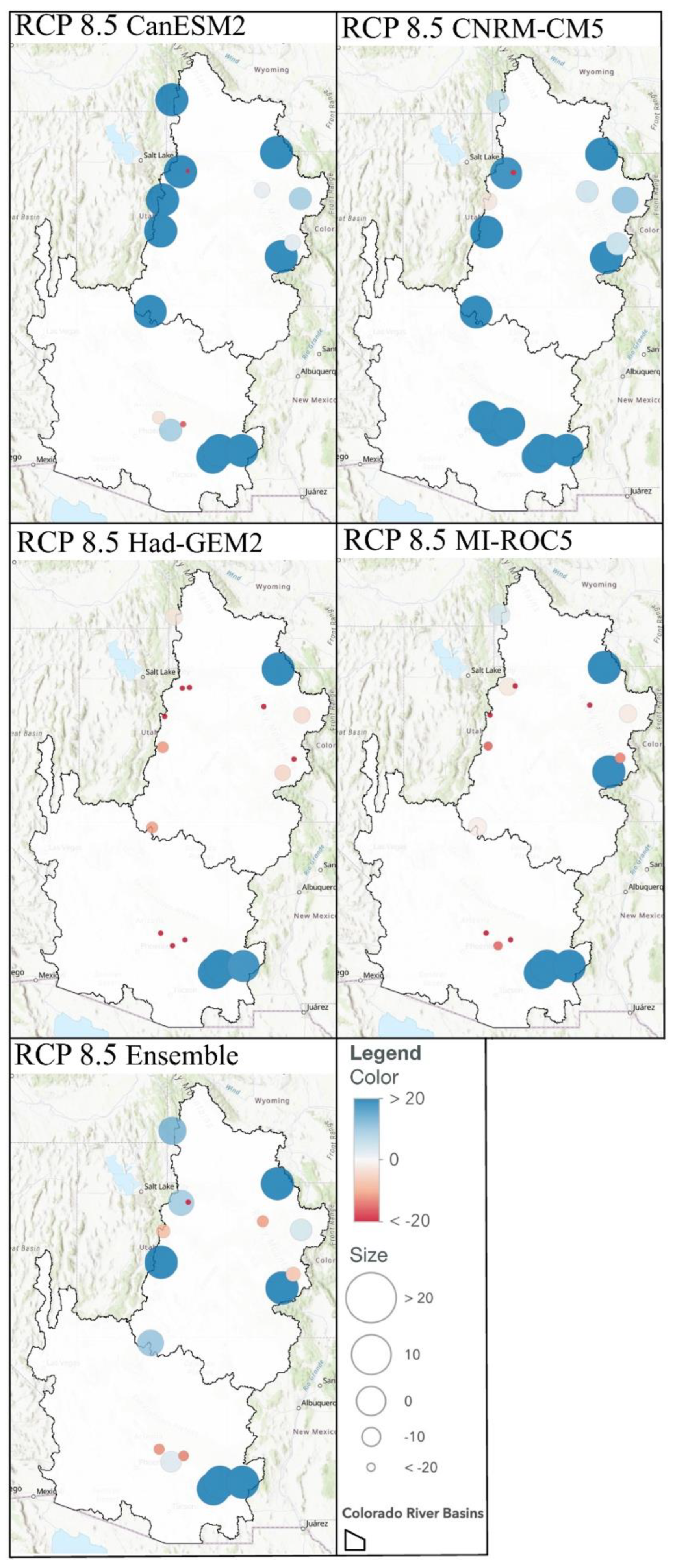

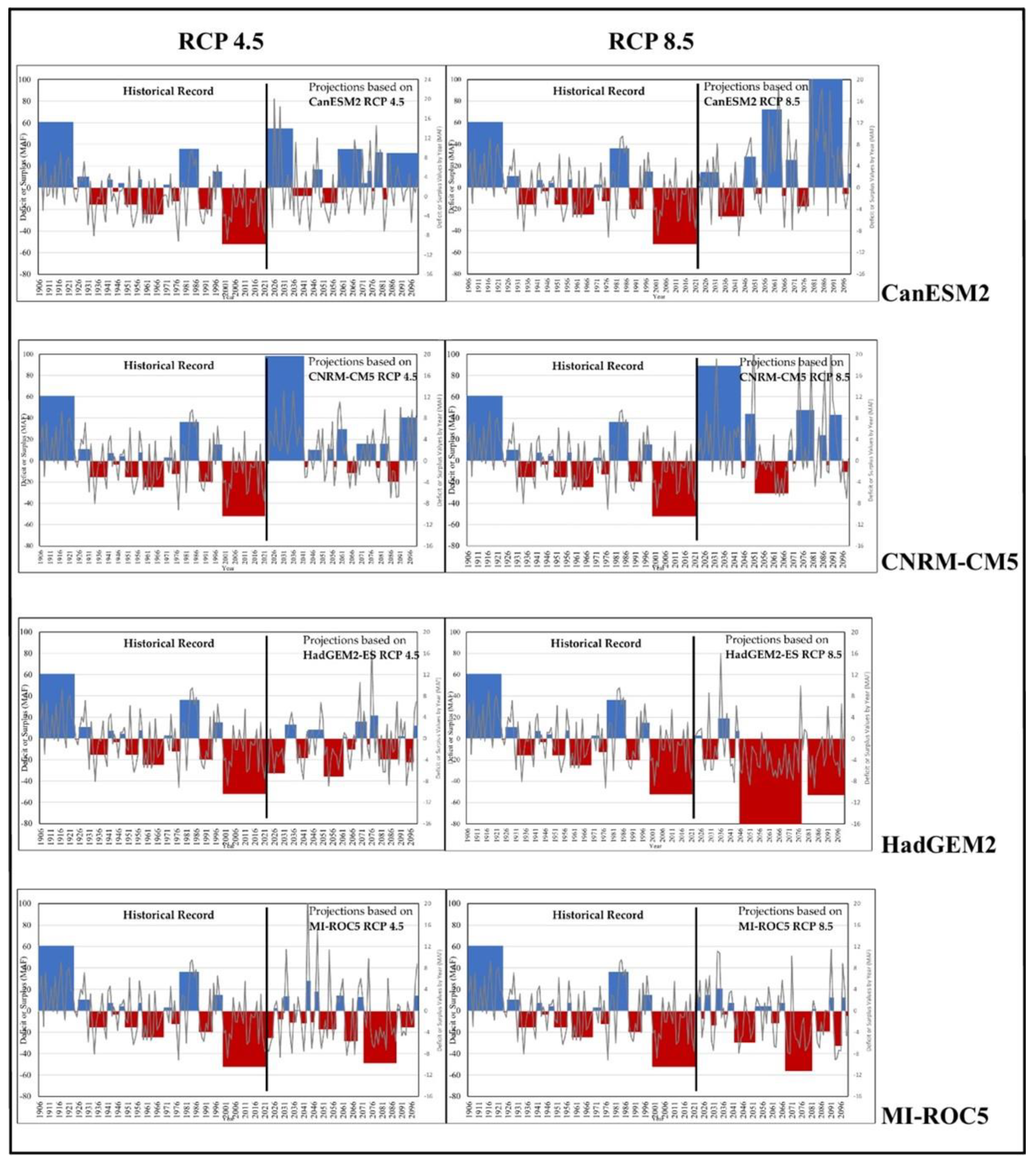
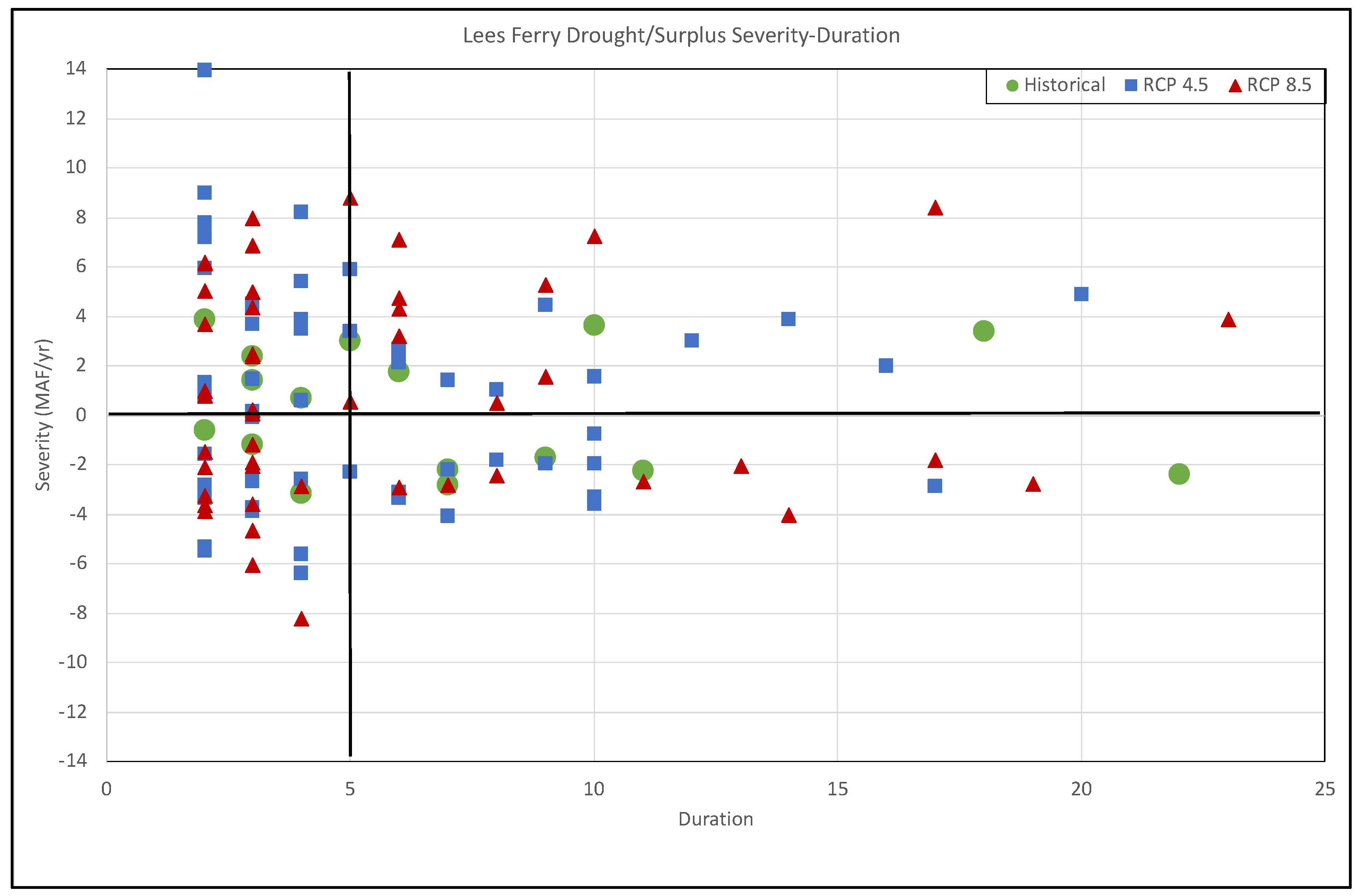
| Station Name | Location/Name | Elevation (m) | Drainage Area (km2) |
|---|---|---|---|
| Lees Ferry | Upper (U1) | 940 | 289,561 |
| Piney River | Upper (U2) | 2217 | 219 |
| East River | Upper (U3) | 2440 | 749 |
| Lake Fork | Upper (U4) | 2386 | 878 |
| Slater Fork | Upper (U5) | 2012 | 391 |
| Rock Creek | Upper (U6) | 2210 | 381 |
| Yellowstone River | Upper (U7) | 2265 | 342 |
| White River | Upper (U8) | 1951 | 1678 |
| Fish Creek | Upper (U9) | 2338 | 156 |
| Muddy Creek | Upper (U10) | 1983 | 272 |
| Smiths Fork | Upper (U11) | 2044 | 427 |
| Gila River | Lower (L1) | 1419 | 4828 |
| San Francisco River | Lower (L2) | 1047 | 7156 |
| Gila River at Safford | Lower (L3) | 957 | 20,350 |
| Salt River Chrysotile | Lower (L4) | 1023 | 7379 |
| Salt River Roosevelt | Lower (L5) | 664 | 11,152 |
| Tonto Creek | Lower (L6) | 769 | 1748 |
| Drought Duration | RCP 4.5 | RCP 8.5 | |||||||
|---|---|---|---|---|---|---|---|---|---|
| Station | Historical | CanESM2 | CNRM-CM5 | HadGEM2-ES | MI-ROC5 | CanESM2 | CNRM-CM5 | HadGEM2-ES | MI-ROC5 |
| Lees Ferry (U) 1907–2021 | 22 | 10 | 6 | 10 | 17 | 13 | 17 | 32 | 14 |
| Lees Ferry (U) 1951–2021 | 11 | 8 | 6 | 10 | 17 | 11 | 8 | 32 | 14 |
| Piney River (U) | 11 | 10 | 11 | 9 | 12 | 7 | 17 | 14 | 19 |
| East River (U) | 9 | 28 | 13 | 12 | 25 | 16 | 12 | 37 | 21 |
| Lake Fork (U) | 17 | 5 | 4 | 7 | 5 | 3 | 4 | 20 | 13 |
| Slater Fork (U) | 9 | 3 | 2 | 3 | 4 | 2 | 4 | 2 | 4 |
| Rock Creek (U) | 22 | 6 | 5 | 18 | 22 | 5 | 11 | 32 | 8 |
| Yellowstone River (U) | 9 | 30 | 27 | 54 | 50 | 18 | 28 | ||
| White River (U) | 11 | 15 | 8 | 17 | 24 | 13 | 17 | 54 | 24 |
| Fish Creek (U) | 11 | 10 | 11 | 24 | 27 | 12 | 21 | 31 | 27 |
| Muddy Creek U) | 15 | 4 | 6 | 14 | 27 | 4 | 4 | 17 | 13 |
| Gila River (L) | 21 | 2 | 7 | 2 | 10 | 4 | |||
| San Franciso River (L) | 27 | 2 | 2 | 3 | 3 | ||||
| Gila at Safford (L) | 28 | ||||||||
| Salt River Chrysotile (L) | 27 | 12 | 50 | 44 | 24 | 12 | 65 | ||
| Salt River Roosevelt (L) | 27 | 19 | 10 | 30 | 44 | 24 | 12 | 57 | 35 |
| Tonto Creek (L) | 23 | 38 | 12 | 23 | 44 | 24 | 17 | 73 | 45 |
| Smiths Fork (L) | 14 | 5 | 11 | 15 | 22 | 5 | 8 | 12 | 13 |
| Surplus Duration | RCP 4.5 | RCP 8.5 | |||||||
| Station | Historical | CanESM2 | CNRM-CM5 | HadGEM2-ES | MI-ROC5 | CanESM2 | CNRM-CM5 | HadGEM2-ES | MI-ROC5 |
| Lees Ferry (U) 1907–2021 | 18 | 16 | 20 | 8 | 4 | 17 | 23 | 6 | 8 |
| Lees Ferry (U) 1951–2021 | 10 | 16 | 20 | 10 | 5 | 18 | 23 | 6 | 11 |
| Piney River (U) | 7 | 17 | 20 | 10 | 6 | 17 | 15 | 7 | 11 |
| East River (U) | 10 | 9 | 11 | 6 | 4 | 17 | 15 | 6 | 11 |
| Lake Fork (U) | 10 | 44 | 65 | 20 | 13 | 27 | 40 | 8 | 11 |
| Slater Fork (U) | 9 | 36 | 20 | 31 | 20 | 38 | 33 | 43 | 30 |
| Rock Creek (U) | 20 | 16 | 20 | 6 | 5 | 21 | 27 | 6 | 8 |
| Yellowstone River (U) | 9 | 3 | 3 | 2 | 2 | 8 | 3 | ||
| White River (U) | 9 | 9 | 20 | 4 | 5 | 15 | 15 | 2 | 3 |
| Fish Creek (U) | 9 | 8 | 15 | 4 | 3 | 15 | 4 | 6 | 8 |
| Muddy Creek U) | 9 | 19 | 18 | 13 | 5 | 19 | 14 | 6 | 3 |
| Gila River (L) | 8 | 30 | 16 | 25 | 15 | 13 | |||
| San Franciso River (L) | 6 | 69 | 70 | 21 | 37 | ||||
| Gila at Safford (L) | 6 | ||||||||
| Salt River Chrysotile (L) | 11 | 6 | 2 | 2 | 9 | 10 | 2 | ||
| Salt River Roosevelt (L) | 11 | 7 | 7 | 6 | 2 | 10 | 16 | 2 | 8 |
| Tonto Creek (L) | 8 | 7 | 6 | 2 | 2 | 7 | 12 | 4 | 3 |
| Smiths Fork (L) | 10 | 14 | 12 | 4 | 10 | 32 | 8 | 11 | 7 |
| Drought Magnitude | RCP 4.5 | RCP 8.5 | |||||||
|---|---|---|---|---|---|---|---|---|---|
| Station | Historical | CanESM2 | CNRM-CM5 | HadGEM2-ES | MI-ROC5 | CanESM2 | CNRM-CM5 | HadGEM2-ES | MI-ROC5 |
| Lees Ferry (U) 1907–2021 | −52.3 | −14.3 | −20.0 | −35.7 | −48.8 | −26.9 | −30.7 | −123.4 | −56.3 |
| Lees Ferry (U) 1951–2021 | −20.9 | −9.2 | −14.8 | −27.1 | −34.1 | −12.3 | −16.8 | −95.8 | −44.2 |
| Piney River (U) | −0.08 | −0.06 | −0.10 | −0.09 | −0.12 | −0.10 | −0.12 | −0.18 | −0.26 |
| East River (U) | −0.33 | −0.89 | −0.44 | −0.77 | −1.02 | −0.60 | −0.63 | −2.56 | −1.59 |
| Lake Fork (U) | −0.18 | −0.05 | −0.07 | −0.21 | −0.16 | −0.18 | −0.04 | −0.71 | −0.37 |
| Slater Fork (U) | −0.13 | −0.05 | −0.05 | −0.02 | −0.07 | −0.03 | −0.02 | −0.05 | −0.07 |
| Rock Creek (U) | −0.87 | −0.06 | −0.11 | −0.38 | −0.56 | −0.13 | −0.14 | −0.96 | −0.23 |
| Yellowstone River (U) | −0.11 | −0.95 | −0.70 | −2.85 | −2.15 | −0.78 | −1.01 | ||
| White River (U) | −0.52 | −1.04 | −1.06 | −2.61 | −2.85 | −1.41 | −1.89 | −10.20 | −3.73 |
| Fish Creek (U) | −0.08 | −0.08 | −0.13 | −0.25 | −0.38 | −0.15 | −0.19 | −0.49 | −0.33 |
| Muddy Creek U) | −0.06 | −0.02 | −0.04 | −0.11 | −0.22 | −0.04 | −0.03 | −0.22 | −0.14 |
| Gila River (L) | −0.69 | −0.03 | −0.08 | −0.06 | −0.14 | −0.10 | |||
| San Franciso River (L) | −0.90 | −0.05 | −0.04 | −0.06 | −0.07 | ||||
| Gila at Safford (L) | −1.99 | ||||||||
| Salt River Chrysotile (L) | −3.11 | −1.44 | −7.68 | −9.54 | −2.03 | −1.64 | −9.70 | ||
| Salt River Roosevelt (L) | −4.14 | −1.83 | −1.21 | −4.02 | −10.77 | −1.34 | −1.32 | −9.64 | −5.13 |
| Tonto Creek (L) | −0.78 | −0.94 | −0.52 | −0.89 | −2.79 | −0.49 | −0.42 | −3.12 | −1.55 |
| Smiths Fork (L) | −0.32 | −0.13 | −0.24 | −0.47 | −0.47 | −0.14 | −0.19 | −0.49 | −0.27 |
| Surplus Magnitude | RCP 4.5 | RCP 8.5 | |||||||
| Station | Historical | CanESM2 | CNRM-CM5 | HadGEM2-ES | MI-ROC5 | CanESM2 | CNRM-CM5 | HadGEM2-ES | MI-ROC5 |
| Lees Ferry (U) 1907–2021 | 60.9 | 54.6 | 98.2 | 21.8 | 27.9 | 142.9 | 89.1 | 19.2 | 20.6 |
| Lees Ferry (U) 1951–2021 | 45.0 | 66.7 | 115.5 | 25.3 | 29.8 | 157.9 | 109.0 | 24.3 | 29.8 |
| Piney River (U) | 0.12 | 0.21 | 0.30 | 0.17 | 0.12 | 0.32 | 0.21 | 0.12 | 0.14 |
| East River (U) | 0.55 | 0.85 | 0.52 | 0.24 | 0.36 | 1.17 | 0.66 | 0.22 | 0.41 |
| Lake Fork (U) | 0.36 | 4.01 | 6.51 | 1.25 | 1.11 | 2.55 | 5.12 | 0.53 | 1.08 |
| Slater Fork (U) | 0.21 | 1.58 | 1.02 | 0.94 | 0.87 | 1.56 | 1.67 | 1.30 | 0.82 |
| Rock Creek (U) | 0.65 | 0.48 | 0.61 | 0.35 | 0.25 | 1.70 | 1.01 | 0.15 | 0.35 |
| Yellowstone River (U) | 0.18 | 0.04 | 0.04 | 0.11 | 0.09 | 0.35 | 0.11 | ||
| White River (U) | 1.04 | 0.85 | 2.72 | 0.46 | 0.88 | 2.12 | 1.68 | 0.58 | 0.50 |
| Fish Creek (U) | 0.18 | 0.11 | 0.13 | 0.09 | 0.07 | 0.55 | 0.13 | 0.05 | 0.03 |
| Muddy Creek U) | 0.12 | 0.40 | 0.48 | 0.18 | 0.10 | 0.79 | 0.31 | 0.06 | 0.08 |
| Gila River (L) | 0.48 | 2.01 | 1.79 | 2.88 | 0.40 | 0.98 | |||
| San Franciso River (L) | 0.71 | 8.33 | 12.03 | 1.96 | 5.13 | ||||
| Gila at Safford (L) | 1.86 | ||||||||
| Salt River Chrysotile (L) | 3.32 | 1.74 | 1.62 | 0.85 | 1.28 | 3.71 | 0.86 | ||
| Salt River Roosevelt (L) | 4.39 | 2.20 | 3.02 | 3.05 | 2.33 | 3.30 | 9.14 | 0.17 | 1.44 |
| Tonto Creek (L) | 1.21 | 0.30 | 0.39 | 0.72 | 0.13 | 0.57 | 1.51 | 0.01 | 0.10 |
| Smiths Fork (L) | 0.17 | 0.80 | 0.42 | 0.30 | 0.20 | 3.36 | 0.31 | 0.42 | 0.29 |
| Station | RCP 4.5 | RCP 8.5 | |||||||||
|---|---|---|---|---|---|---|---|---|---|---|---|
| Historical | CanESM2 | CNRM-CM5 | HadGEM2-ES | MI-ROC5 | Ensemble | CanESM2 | CNRM-CM5 | HadGEM2-ES | MI-ROC5 | Ensemble | |
| Lees Ferry (U) 1906–2021 | 14.7 | 16.7 | 16.8 | 13.6 | 13.8 | 15.2 | 17.7 | 17.3 | 12.3 | 13.6 | 15.2 |
| Lees Ferry (U) 1951–2021 | 13.8 | 16.7 | 16.8 | 13.6 | 13.8 | 15.2 | 17.7 | 17.3 | 12.3 | 13.6 | 15.2 |
| Piney River (U) | 0.055 | 0.061 | 0.060 | 0.056 | 0.056 | 0.058 | 0.060 | 0.061 | 0.053 | 0.054 | 0.057 |
| East River (U) | 0.228 | 0.239 | 0.230 | 0.195 | 0.207 | 0.218 | 0.233 | 0.240 | 0.174 | 0.199 | 0.212 |
| Lake Fork (U) | 0.162 | 0.252 | 0.259 | 0.197 | 0.207 | 0.229 | 0.241 | 0.268 | 0.155 | 0.194 | 0.215 |
| Slater Fork (U) | 0.057 | 0.093 | 0.093 | 0.086 | 0.083 | 0.089 | 0.101 | 0.096 | 0.085 | 0.084 | 0.092 |
| Rock Creek (U) | 0.096 | 0.120 | 0.116 | 0.084 | 0.093 | 0.103 | 0.140 | 0.114 | 0.076 | 0.094 | 0.106 |
| Yellowstone River (U) | 0.098 | 0.074 | 0.073 | 0.050 | 0.059 | 0.064 | 0.087 | 0.072 | 0.044 | 0.060 | 0.066 |
| White River (U) | 0.432 | 0.437 | 0.457 | 0.348 | 0.363 | 0.401 | 0.439 | 0.452 | 0.288 | 0.340 | 0.380 |
| Fish Creek (U) | 0.034 | 0.035 | 0.033 | 0.026 | 0.024 | 0.030 | 0.045 | 0.033 | 0.024 | 0.024 | 0.032 |
| Muddy Creek U) | 0.027 | 0.042 | 0.041 | 0.027 | 0.025 | 0.034 | 0.050 | 0.039 | 0.024 | 0.023 | 0.034 |
| Gila River (L) | 0.118 | 0.183 | 0.228 | 0.168 | 0.167 | 0.187 | 0.200 | 0.244 | 0.140 | 0.172 | 0.189 |
| San Franciso River (L) | 0.153 | 0.301 | 0.382 | 0.273 | 0.266 | 0.306 | 0.319 | 0.407 | 0.227 | 0.274 | 0.307 |
| Gila at Safford (L) | 0.338 | 0.754 | 0.925 | 0.688 | 0.665 | 0.758 | 0.808 | 0.982 | 0.582 | 0.686 | 0.765 |
| Salt River Chrysotile (L) | 0.447 | 0.388 | 0.488 | 0.335 | 0.307 | 0.379 | 0.406 | 0.538 | 0.280 | 0.329 | 0.388 |
| Salt River Roosevelt (L) | 0.579 | 0.596 | 0.746 | 0.520 | 0.456 | 0.580 | 0.633 | 0.834 | 0.433 | 0.494 | 0.599 |
| Tonto Creek (L) | 0.110 | 0.096 | 0.117 | 0.085 | 0.066 | 0.091 | 0.108 | 0.137 | 0.070 | 0.074 | 0.097 |
| Smiths Fork (L) | 0.135 | 0.170 | 0.146 | 0.126 | 0.131 | 0.143 | 0.206 | 0.142 | 0.132 | 0.139 | 0.155 |
Publisher’s Note: MDPI stays neutral with regard to jurisdictional claims in published maps and institutional affiliations. |
© 2022 by the authors. Licensee MDPI, Basel, Switzerland. This article is an open access article distributed under the terms and conditions of the Creative Commons Attribution (CC BY) license (https://creativecommons.org/licenses/by/4.0/).
Share and Cite
Bedri, R.; Piechota, T. Future Colorado River Basin Drought and Surplus. Hydrology 2022, 9, 227. https://doi.org/10.3390/hydrology9120227
Bedri R, Piechota T. Future Colorado River Basin Drought and Surplus. Hydrology. 2022; 9(12):227. https://doi.org/10.3390/hydrology9120227
Chicago/Turabian StyleBedri, Rama, and Thomas Piechota. 2022. "Future Colorado River Basin Drought and Surplus" Hydrology 9, no. 12: 227. https://doi.org/10.3390/hydrology9120227
APA StyleBedri, R., & Piechota, T. (2022). Future Colorado River Basin Drought and Surplus. Hydrology, 9(12), 227. https://doi.org/10.3390/hydrology9120227







